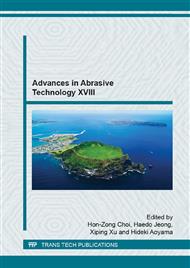p.435
p.440
p.446
p.455
p.461
p.466
p.472
p.478
p.484
Influence of Components on the Rheological Property of Shear Thickening Polishing Slurry
Abstract:
Shear thickening polishing (STP) method was newly developed to achieve high efficient and high quality finishing of complex curved surface. The shear thickening fluid based slurry is one of the key factors in STP process. Viscosity of different shear thickening polishing slurry (STPS) was tested by rheometer in this study. The influences of dispersed particle size and concentration, abrasive material, abrasive particle size and concentration on the rheological property of STPS were analyzed. The results show that smaller dispersed particle (5.5 or 13μm in this study) and relative higher concentration (50-55 wt.%) are better for shear thickening effect of the base fluid. The viscosity of base fluid increases from 0.15-0.3 Pa·s to 0.8-1.1 Pa·s under high shear rate. The participation of Al2O3 and diamond abrasive changes the rheological property little, and the viscosity of STPS reaches the highest value 1.8 Pa·s at shear rate 300 s-1. But SiC abrasive obviously destroys the shear thickening effect. SPTS with different Al2O3 abrasive concentration in this study presents almost same viscosity curve. It is inferred that the number of the abrasive particle but not the weight ratio plays the role to effect the rheological property of STPS.
Info:
Periodical:
Pages:
461-465
Citation:
Online since:
January 2016
Authors:
Price:
Сopyright:
© 2016 Trans Tech Publications Ltd. All Rights Reserved
Share:
Citation:


